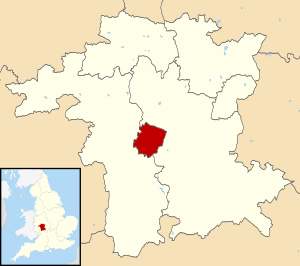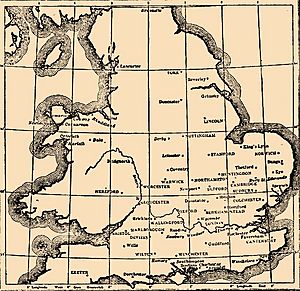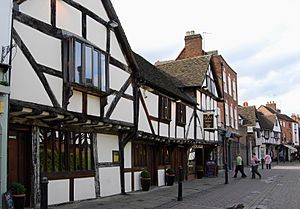Jewish community of Worcester, England facts for kids
Quick facts for kids
City of Worcester, England
|
|
|---|---|

City of Worcester, shown within Worcestershire
|
Worcester, a city in England, was once home to a small Jewish community. This community existed during the Middle Ages, a very long time ago. They often helped people by lending money.
In 1241, an important meeting of Jewish leaders from all over England happened in Worcester. The King wanted to know how much money they had for taxes. Sadly, the local church leaders in Worcester were not friendly to the Jewish community. They even wrote things against Jewish people and wanted Jews and Christians to live separately.
During a conflict called the Second Barons' War, Jewish people in Worcester faced violence. Many died in 1255 because of supporters of Simon de Montfort.
The Jewish community was forced to leave Worcester in 1275. Most of them moved to Hereford. Later, in 1290, all Jewish people were expelled from England. This meant they had to leave the country.
Many centuries later, during the Second World War, a Jewish community was started again in Worcester. However, after the war, the community became smaller. Their synagogue, a place of worship, closed in 1973.
Contents
Jewish Life in Medieval Worcester
Like many important towns, Worcester had a Jewish community as early as the 1100s.
First Records of Jews in Worcester
The first mention of Jewish families in Worcester is from 1154. They likely earned a living by lending money to local people. This was common for Jewish communities in other English towns.
In 1184, a Jewish man named Bonefei had to pay a fine to the King's court. A few years later, a money lender named Leo the Jew lent money to the abbot of Pershore. He was put in prison for trying to get back what he was owed.
The Archa System
Worcester was one of 26 towns that had an archa. An archa was a special chest with three locks and seals. It held copies of all agreements and contracts involving Jewish people. This system helped keep important records safe.
King King Richard I introduced archae after many Jewish people were attacked in 1189-1190. During these attacks, financial records were often destroyed. This caused the King to lose money from taxes. The archae were meant to protect the King's rights and ensure records were safe.
Each city with an archa became a center for Jewish business. A special office was set up with two Jewish people and two Christian clerks. They worked under the King's financial department, called the Exchequer of the Jews.
Jewish Quarter and Royal Protection
King Henry III became King in 1216. He officially allowed Jewish people to live in Worcester. There is some evidence that Jewish people might have lived in a specific area. This area was called Cooken or Coken Street (now Copenhagen Street).
Church Hostility Towards Jews
The local church leaders in Worcester were very unfriendly to the Jewish community. Around 1190, a Bishop of Worcester asked Peter of Blois to write a strong anti-Jewish book.
William de Blois, who was Bishop of Worcester, made very strict rules for Jews in 1219. Like elsewhere in England, Jews were forced to wear square white badges. This was supposed to show they were Jewish. Often, people could pay a fine to avoid wearing the badge. But Blois insisted on it.
He also tried to make rules about money lending. In 1229, he wrote to Pope Gregory asking for even stricter measures. The Pope then demanded that Christians should not work in Jewish homes. He also insisted that Jews must wear their badges.
The "Jewish Parliament" of 1241
In 1241, King Henry III called a meeting in Worcester. It was later called a "Jewish parliament." However, it was not a real parliament. It was a meeting to figure out how much money Jewish people in England could pay in taxes. After this meeting, Henry collected a very large tax from his Jewish subjects.
Attacks During the Barons' War
In 1263, during a revolt led by Simon de Montfort, a rebel leader named Robert Ferrers attacked Worcester. He let his soldiers attack the city and destroy the Jewish community. Ferrers also took the archae. This helped him get rid of records of his own debts.
The attack in Worcester was part of a bigger plan by the De Montforts. They wanted to weaken King Henry III. Simon de Montfort had also attacked Jewish communities in Leicester. Jewish people in London were also attacked during this war.
Expulsion from Worcester and England
In 1272, Edward I became King of England. When he married Eleanor in 1275, he gave her the cities of Worcester, Bath, and Gloucester. King Edward then ordered that "no Jew may dwell or abide in any of the towns which the queen has for her dower." This meant the Jews of Worcester had to move to Hereford.
Finally, in 1290, all Jewish people were expelled from England. This included the former Jews of Worcester.
Jewish Community Returns to Worcester in 1941
It took 651 years for a Jewish community to be reestablished in Worcester. In 1941, the Jewish Chronicle newspaper announced its return.
Why the Community Returned
The community was reestablished to help Jewish people who had moved from London and Birmingham. They were evacuees escaping the German bombings during World War 2. Many Jewish refugees from Europe also settled in Worcester.
These new Jewish residents became part of Worcester's economy. For example, Emil Rich, a refugee from Germany, started the Milore Glove factory.
Support for the New Community
American and other Jewish servicemen stationed nearby also joined the community during the war. Services were held in the city. With help from Rabbi Reuben Rabinowitz, Hebrew classes for children were started.
At first, services were held in temporary places. But in March 1943, a synagogue was opened at 2 New Street. The Chief Rabbi of Britain officially opened it. Mr. Isaac Wolfson, a well-known businessman living in Worcester, performed the opening ceremony.
The synagogue hired Rev. J. Rockman as a reader and Hebrew teacher. Mr. J. Zuck was the community chairman. The building also had a canteen and social rooms for servicemen and workers. The first barmitzvah, a special ceremony for Jewish boys, was held in Worcester in February 1943 for Stanley Davis.
Jewish Community After World War II
After World War II ended, most of the Jewish community members returned to their original, larger communities. However, a small group stayed in Worcester. They continued to support the synagogue. Regular services were held, and children's classes continued.
In 1960, the community decided to rebuild part of the synagogue. It had become unsafe. Dr. Wolf Hirshow, the chairman, and Mr. A.J. Berger, the vice chairman, led this project.
Decline of the Community
The synagogue continued to operate until January 1973. By then, it became very hard to gather enough people for services. A minyan (a group of ten adults needed for some prayers) was difficult to form. The remaining members decided to close the community.
One Sefer Torah (a holy scroll) that had been borrowed from Birmingham in 1940 was returned. Another Sefer Torah was given to a new Jewish community in Israel.



